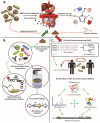Advances in the Microbiome: Applications to Clostridium difficile Infection
- PMID: 27657145
- PMCID: PMC5039486
- DOI: 10.3390/jcm5090083
Advances in the Microbiome: Applications to Clostridium difficile Infection
Abstract
Clostridium difficile is a major cause of morbidity and mortality worldwide, causing over 400,000 infections and approximately 29,000 deaths in the United States alone each year. C. difficile is the most common cause of nosocomial diarrhoea in the developed world, and, in recent years, the emergence of hyper-virulent (mainly ribotypes 027 and 078, sometimes characterised by increased toxin production), epidemic strains and an increase in the number of community-acquired infections has caused further concern. Antibiotic therapy with metronidazole, vancomycin or fidaxomicin is the primary treatment for C. difficile infection (CDI). However, CDI is unique, in that, antibiotic use is also a major risk factor for acquiring CDI or recurrent CDI due to disruption of the normal gut microbiota. Therefore, there is an urgent need for alternative, non-antibiotic therapeutics to treat or prevent CDI. Here, we review a number of such potential treatments which have emerged from advances in the field of microbiome research.
Keywords: Clostridium difficile; antibiotic resistance; bacteriocin; faecal microbiota transplantation (FMT); genome sequencing; gut microbiota; human gut microbiome; nanopore sequencing; probiotics; synthetic biology.
Conflict of interest statement
The authors declare no conflict of interest. The founding sponsors had no role in the design of the study; in the collection, analyses or interpretation of data; in the writing of the manuscript, and in the decision to publish the results.
Figures

Similar articles
-
Update of treatment algorithms for Clostridium difficile infection.Clin Microbiol Infect. 2018 May;24(5):452-462. doi: 10.1016/j.cmi.2017.12.022. Epub 2018 Jan 6. Clin Microbiol Infect. 2018. PMID: 29309934 Review.
-
Best strategies in recurrent or persistent Clostridium difficile infection.Surg Infect (Larchmt). 2011 Jun;12(3):235-9. doi: 10.1089/sur.2010.080. Epub 2011 Jul 18. Surg Infect (Larchmt). 2011. PMID: 21767157 Review.
-
Impact of Oral Fidaxomicin Administration on the Intestinal Microbiota and Susceptibility to Clostridium difficile Colonization in Mice.Antimicrob Agents Chemother. 2018 Apr 26;62(5):e02112-17. doi: 10.1128/AAC.02112-17. Print 2018 May. Antimicrob Agents Chemother. 2018. PMID: 29463537 Free PMC article.
-
Faecal Microbiota Transplantation is Effective for the Initial Treatment of Clostridium difficile Infection: A Retrospective Clinical Review.Infect Dis Ther. 2020 Dec;9(4):935-942. doi: 10.1007/s40121-020-00339-w. Epub 2020 Sep 26. Infect Dis Ther. 2020. PMID: 32979161 Free PMC article.
-
The potential for emerging therapeutic options for Clostridium difficile infection.Gut Microbes. 2014;5(6):696-710. doi: 10.4161/19490976.2014.983768. Gut Microbes. 2014. PMID: 25564777 Free PMC article. Review.
Cited by
-
Efficient protection of microorganisms for delivery to the intestinal tract by cellulose sulphate encapsulation.Microb Cell Fact. 2020 Nov 26;19(1):216. doi: 10.1186/s12934-020-01465-3. Microb Cell Fact. 2020. PMID: 33243224 Free PMC article.
-
Clostridioides difficile infection in thoroughbred horses in Japan from 2010 to 2021.Sci Rep. 2023 Aug 11;13(1):13099. doi: 10.1038/s41598-023-40157-x. Sci Rep. 2023. PMID: 37567893 Free PMC article.
-
Genome-Based Comparison of Clostridioides difficile: Average Amino Acid Identity Analysis of Core Genomes.Microb Ecol. 2018 Oct;76(3):801-813. doi: 10.1007/s00248-018-1155-7. Epub 2018 Feb 14. Microb Ecol. 2018. PMID: 29445826 Free PMC article.
-
Association between ribotype and clinical form of enterocolitis with C. difficile in Western Romania: A 2-year study.Exp Ther Med. 2022 Jan;23(1):22. doi: 10.3892/etm.2021.10944. Epub 2021 Nov 3. Exp Ther Med. 2022. PMID: 34815774 Free PMC article.
-
The microbiome impacts host hybridization and speciation.PLoS Biol. 2021 Oct 26;19(10):e3001417. doi: 10.1371/journal.pbio.3001417. eCollection 2021 Oct. PLoS Biol. 2021. PMID: 34699520 Free PMC article.
References
Publication types
LinkOut - more resources
Full Text Sources
Other Literature Sources

